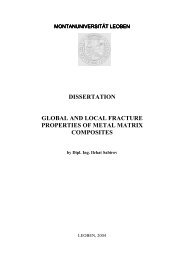1 - Erich Schmid Institute
1 - Erich Schmid Institute
1 - Erich Schmid Institute
Create successful ePaper yourself
Turn your PDF publications into a flip-book with our unique Google optimized e-Paper software.
A.6 Discussion of Possible Sources of Error<br />
to take a closer look on the stresses in the thin film during the annealing process and the<br />
actual cantilever experiment.<br />
The film was annealed at 600 ◦ C to obtain a nearly stress-free state. On cooling to room<br />
temperature, the thermal stress in the Ni film according to the coefficients of thermal<br />
expansion (αSi = 2.6 × 10 −6 K −1 and αNi = 16 × 10 −6 K −1 ) 12, 13 should be 1330MP a,<br />
which is significantly greater than the experimentally determined mean stress. Those high<br />
stresses are reduced by plastic relaxation in the thin film, which leads to the determined<br />
stress distribution.<br />
However, during the fabrication of the cantilever and the subsequent gradual reduction<br />
in the film thickness, the stress distribution in the thin film changes and additional plastic<br />
deformation could be the result.<br />
A closer look at the stress distribution of the relaxed cantilever shows that the maximum<br />
stress of 620 ± 87MP a appears during the reduction of the Ni film thickness<br />
when the majority of the thin film is removed (Fig.A.14). The minimum stress of about<br />
−300±20MP a is found for a film thickness of about 650nm. Although the maximum and<br />
minimum stresses that appear in the Ni film during the experiment are not negligible,<br />
they are lower than the maximum stress in the initial system (792 ± 103MP a). Furthermore,<br />
the calculated and the measured deflections of the second cantilever experiment,<br />
in which the cantilever thickness is reduced bottom-up, would not correlate if notable<br />
plastic relaxation occurred. This leads to the conclusion that a significant change in the<br />
stress field due to plastic deformation does not take place during the experiments.<br />
Figure A.14: Minimum and maximum stresses σf,min and σf,max (black lines) in the Ni film of the<br />
relaxed cantilever, which occur during the top-down removal of the sublayers, as a function<br />
of the cantilever thickness. The grey lines represent the upper and lower bound for the<br />
minimum and maximum stresses calculated from the determined stress distribution in the<br />
initial system plus/minus the standard deviation. The stresses in sublayer 1 (sl 1) are<br />
not evaluated, because it is regarded as a composite material with one biaxial Young’s<br />
modulus.<br />
Finally, it should be noted that in critical cases, the choice of an adequate cantilever<br />
thickness can be used to reduce the stresses in the thin film and avoid plastic relaxation.<br />
A–17<br />
A
















